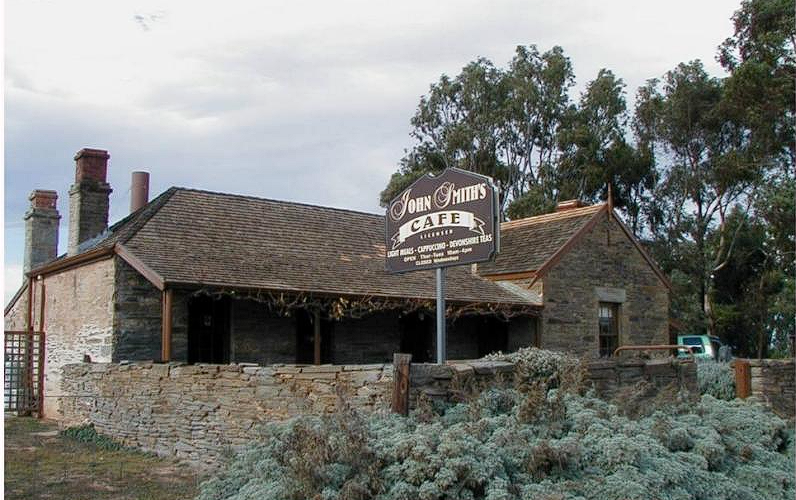One of the oldest construction techniques in existence, Dry stone walling involves constructing walls by simply stacking stones on top of each other.

Unlike brick walls, which require wet mortar to hold them together, dry stone walling involves no mortar at all.
These walls simply rely on gravity, along with the skills of those who build them, for their stability.
Jump to section:
Hill River Station - Old Canowie - Browne Hill Range - Bundaleer - Hampton - Princess Royal, The Gap - Mintaro & Kadlunga - Stone fence stops fire - Reference

Camel Hump Wall, Hill River Station
The longest continuous dry stone wall in Australia is the Camel Hump Wall, which stretches approximately 65 kilometres from Farrell Flat to Booborowie in South
Australia's mid-north, along the Camel's Hump and into the Browne Hill Ranges.
No one can doubt that this wall starts at Hill River Station, by Claremont Farm, and was built for old Colonist C. B. Fisher.
More information: claremuseum.com | Heard about the great Hill River Stone Wall?


Hill River Station was once the largest farm in S.A. and was the jewel in the crown of early businessman C.B. Fisher.
The first three kilometres of this wall pass Gerald Lally's Claremont Farm, formerly part of Gum Creek Station .
This southern section of the wall first appears on a map from 1860.
See - Farming on a Large Scale
The first sixteen km. of this wall were built by Patrick (or Peter) O'Grady.

Above: The last section of Camel's Hump Wall passes through Munduney Station on the huge historic Canowie run.


2. Old Canowie homestead surrounds.
Initially established over 80,000 acres, this station carried 63,000 sheep. The dry stone walls there are legendary.
This historic pastoral property was west of Hallett on the way to Jamestown, and was taken up as part of the Drs William and James Browne’s Booborowie run in 1843 when it totalled 319 square miles.

The front paddock along Wilkins Drive has a dry stone wall at least 300 metres long, recently renovated.

3. Browne Hill Range
This is actually the top end of the Camel Hump Range, and the northern end of the old dry stone wall 65 km. long from Claremont farm.

4. Bundaleer and Campbell Range


Bundaleer forest was planted as recommended by George Goyder in 1876.
It has water, stone, and dry stone walls, and now covers 3200 hectares, the first forest plantation in Australia.
5. Hampton Village (near Burra)
On the outskirts of Burra, the stone ruins and foundations are the only remains of the former township of Hampton Village, once a bustling settlement during the peak mining period in Burra from the1860s.

Following the discovery of copper in Burra, the South Australian Mining Association laid out the town of Kooringa in 1846.
To provide alternative housing for the miners and their families, the townships of Redruth, Aberdeen, Llwchwr and Hampton were a privately surveyed.
The sale of allotments began in 1858 and by 1866, over 30 dwellings and a Chapel sat beside the stone quarry of Hampton Village.

The houses in Hampton village were predominantly simple two or three roomed cottages built from stone from the local quarry, inhabited mainly by copper miners and a few farmers.
6. Princess Royal Station and the Gap

A dry stone wall forms the southern boundary with the neighbouring property, "The Gap" as it marches up a huge hill from the Burra Creek, totalling over four kilometres.
There is the ruin of a dry stone Shepherd's Hut at The Gap, similar to this ruin at Bimbowrie.

7. Mintaro and Kadlunga
"Mintaro",wrote Bruce Munday, "partly because of its world famous slate, salutes stone in a graceful manner."
Yvonne's Slideshow of Mintaro and Kadlunga dry stone walls

Slideshow: Heritage S.A. Mintaro dry-stone walls
Stone Fences and Fire
A STONE wall made about 150 years ago helped stop a grassfire on a property near Moculta during South Australia's bushfires last week. The wall, built by the early settlers, halted the grassfire in its tracks at the property, which was hit by the Eden Valley fires. ADVERTISER - 21 Jan 2014
SA author Bruce Munday was helping to mop up the fires on Sunday when he saw the remarkable impact the stone wall had on the blaze.
For Mr Munday, who wrote a book on the dry-stone walls that run across South Australia, it's another lesson from the people who settled the state.
Reference:
"Those Dry Stone Walls Revisited" by Bruce Munday and Kristin Munday.
"Beautiful stone was nature’s gift to South Australia, and an irresistible building material for early settlers. Many stone walls, without mortar or with no more than mud to stem the breeze, have defied gravity and the elements all these years. Or did gravity combine with friction and deft balance to sustain them?"
Join Bruce Munday (pictured above) and Kristin Munday as they traverse South Australia in search of those walls, seeking answers and documenting the adventure.
Discover historic masterpieces and insights into rural life in the years following European settlement.
And meet the custodians of the walls, rightly proud of this heritage, who shared their stories.
Also See:

Dry stone walls should be heritage listed before constructions fall into disrepair, organisation says (ABC 17 May 2015)
The fight to restore Australia's historic dry stone walls (ABC 3 April 2024)





















Comments